1. Einav S, Zimmerman FS, Tankel J, Leone M. Management of the patient with the open abdomen. Curr Opin Crit Care. 2021; 27:726–732. PMID:
34561356.
2. Cristaudo A, Jennings S, Gunnarsson R, DeCosta A. Complications and mortality associated with temporary abdominal closure techniques: a systematic review and meta-analysis. Am Surg. 2017; 83:191–216. PMID:
28228207.
3. Boolaky KN, Tariq AH, Hardcastle TC. Open abdomen in the trauma ICU patient: who? when? why? and what are the outcome results? Eur J Trauma Emerg Surg. 2022; 48:953–961. PMID:
33205225.
4. Quyn AJ, Johnston C, Hall D, Chambers A, Arapova N, Ogston S, et al. The open abdomen and temporary abdominal closure systems: historical evolution and systematic review. Colorectal Dis. 2012; 14:e429–e438. PMID:
22487141.
5. Milne DM, Rambhajan A, Ramsingh J, Cawich SO, Naraynsingh V. Managing the open abdomen in damage control surgery: should skin-only closure be abandoned? Cureus. 2021; 13:e15489. PMID:
34268021.
6. Sharrock AE, Barker T, Yuen HM, Rickard R, Tai N. Management and closure of the open abdomen after damage control laparotomy for trauma: a systematic review and meta-analysis. Injury. 2016; 47:296–306. PMID:
26462958.
8. Coccolini F, Roberts D, Ansaloni L, Ivatury R, Gamberini E, Kluger Y, et al. The open abdomen in trauma and non-trauma patients: WSES guidelines. World J Emerg Surg. 2018; 13:7. PMID:
29434652.
9. Godat L, Kobayashi L, Costantini T, Coimbra R. Abdominal damage control surgery and reconstruction: world society of emergency surgery position paper. World J Emerg Surg. 2013; 8:53. PMID:
24341602.
10. Diaz JJ, Cullinane DC, Dutton WD, Jerome R, Bagdonas R, Bilaniuk JW, et al. The management of the open abdomen in trauma and emergency general surgery: part 1-damage control. J Trauma. 2010; 68:1425–1438. PMID:
20539186.
11. Chiara O, Cimbanassi S, Biffl W, Leppaniemi A, Henry S, Scalea TM, et al. International consensus conference on open abdomen in trauma. J Trauma Acute Care Surg. 2016; 80:173–183. PMID:
27551925.
12. Bradley M, Galvagno S, Dhanda A, Rodriguez C, Lauerman M, DuBose J, et al. Damage control resuscitation protocol and the management of open abdomens in trauma patients. Am Surg. 2014; 80:768–775. PMID:
25105395.
13. Page MJ, McKenzie JE, Bossuyt PM, Boutron I, Hoffmann TC, Mulrow CD, et al. The PRISMA 2020 statement: an updated guideline for reporting systematic reviews. Syst Rev. 2021; 10:89. PMID:
33781348.
15. Balduzzi S, Rücker G, Schwarzer G. How to perform a meta-analysis with R: a practical tutorial. Evid Based Ment Health. 2019; 22:153–160. PMID:
31563865.
16. Sterne JA, Savović J, Page MJ, Elbers RG, Blencowe NS, Boutron I, et al. RoB 2: a revised tool for assessing risk of bias in randomised trials. BMJ. 2019; 366:l4898. PMID:
31462531.
17. Wells G, Shea B, O’Connell D, Peterson J, Welch V, Losos M, et al. The Newcastle-Ottawa Scale (NOS) for assessing the quality of nonrandomised studies in meta-analyses [Internet]. Ottawa Hospital Research Institute;2021. cited 2022 Apr 25. Available from:
http://www.ohri.ca/programs/clinical_epidemiology/oxford.asp
.
18. Smith JW, Matheson PJ, Franklin GA, Harbrecht BG, Richardson JD, Garrison RN. Randomized controlled trial evaluating the efficacy of peritoneal resuscitation in the management of trauma patients undergoing damage control surgery. J Am Coll Surg. 2017; 224:396–404. PMID:
28137537.
19. Kirkpatrick AW, Roberts DJ, Faris PD, Ball CG, Kubes P, Tiruta C, et al. Active negative pressure peritoneal therapy after abbreviated laparotomy: the intraperitoneal vacuum randomized controlled trial. Ann Surg. 2015; 262:38–46. PMID:
25536308.
20. Burch JM, Ortiz VB, Richardson RJ, Martin RR, Mattox KL, Jordan GL. Abbreviated laparotomy and planned reoperation for critically injured patients. Ann Surg. 1992; 215:476–484. PMID:
1616384.
21. Smith PC, Tweddell JS, Bessey PQ. Alternative approaches to abdominal wound closure in severely injured patients with massive visceral edema. J Trauma. 1992; 32:16–20. PMID:
1732567.
22. Offner PJ, de Souza AL, Moore EE, Biffl WL, Franciose RJ, Johnson JL, et al. Avoidance of abdominal compartment syndrome in damage-control laparotomy after trauma. Arch Surg. 2001; 136:676–681. PMID:
11387007.
23. Hu P, Uhlich R, Gleason F, Kerby J, Bosarge P. Impact of initial temporary abdominal closure in damage control surgery: a retrospective analysis. World J Emerg Surg. 2018; 13:43. PMID:
30237824.
24. Mayberry JC, Burgess EA, Goldman RK, Pearson TE, Brand D, Mullins RJ. Enterocutaneous fistula and ventral hernia after absorbable mesh prosthesis closure for trauma: the plain truth. J Trauma. 2004; 57:157–163. PMID:
15284567.
25. Cohn SM, Burns GA, Sawyer MD, Tolomeo C, Milner KA, Spector S. Esmarch closure of laparotomy incisions in unstable trauma patients. J Trauma. 1995; 39:978–979. PMID:
7474018.
26. Yeh KA, Saltz R, Howdieshell TR. Abdominal wall reconstruction after temporary abdominal wall closure in trauma patients. South Med J. 1996; 89:497–502. PMID:
8638177.
27. Vertrees A, Kellicut D, Ottman S, Peoples G, Shriver C. Early definitive abdominal closure using serial closure technique on injured soldiers returning from Afghanistan and Iraq. J Am Coll Surg. 2006; 202:762–772. PMID:
16648016.
28. Vertrees A, Greer L, Pickett C, Nelson J, Wakefield M, Stojadinovic A, et al. Modern management of complex open abdominal wounds of war: a 5-year experience. J Am Coll Surg. 2008; 207:801–809. PMID:
19183525.
29. Nagy KK, Fildes JJ, Mahr C, Roberts RR, Krosner SM, Joseph KT, et al. Experience with three prosthetic materials in temporary abdominal wall closure. Am Surg. 1996; 62:331–335. PMID:
8615556.
30. Fernandez L, Norwood S, Roettger R, Wilkins HE. Temporary intravenous bag silo closure in severe abdominal trauma. J Trauma. 1996; 40:258–260. PMID:
8637075.
31. Sánchez-Lozada R, Ortiz-González J, Dolores-Velázquez R, Soto-Villagrán R, Gutiérrez-Vega R. Open vs. closed abdomen in acute peritonitis: a comparative study. Gac Med Mex. 2004; 140:295–298. PMID:
15259341.
32. Weinberg JA, George RL, Griffin RL, Stewart AH, Reiff DA, Kerby JD, et al. Closing the open abdomen: improved success with Wittmann patch staged abdominal closure. J Trauma. 2008; 65:345–348. PMID:
18695469.
33. Hadeed JG, Staman GW, Sariol HS, Kumar S, Ross SE. Delayed primary closure in damage control laparotomy: the value of the Wittmann patch. Am Surg. 2007; 73:10–12. PMID:
17249448.
34. Smith JW, Garrison RN, Matheson PJ, Franklin GA, Harbrecht BG, Richardson JD. Direct peritoneal resuscitation accelerates primary abdominal wall closure after damage control surgery. J Am Coll Surg. 2010; 210:658–667. PMID:
20421025.
35. Barker DE, Kaufman HJ, Smith LA, Ciraulo DL, Richart CL, Burns RP. Vacuum pack technique of temporary abdominal closure: a 7-year experience with 112 patients. J Trauma. 2000; 48:201–207. PMID:
10697075.
36. Johnson JW, Gracias VH, Schwab CW, Reilly PM, Kauder DR, Shapiro MB, et al. Evolution in damage control for exsanguinating penetrating abdominal injury. J Trauma. 2001; 51:269–271.
37. Chavarria-Aguilar M, Cockerham WT, Barker DE, Ciraulo DL, Richart CM, Maxwell RA. Management of destructive bowel injury in the open abdomen. J Trauma. 2004; 56:560–564. PMID:
15128127.
38. Garner GB, Ware DN, Cocanour CS, Duke JH, McKinley BA, Kozar RA, et al. Vacuum-assisted wound closure provides early fascial reapproximation in trauma patients with open abdomens. Am J Surg. 2001; 182:630–638. PMID:
11839329.
39. Suliburk JW, Ware DN, Balogh Z, McKinley BA, Cocanour CS, Kozar RA, et al. Vacuum-assisted wound closure achieves early fascial closure of open abdomens after severe trauma. J Trauma. 2003; 55:1155–1161. PMID:
14676665.
40. Stone PA, Hass SM, Flaherty SK, DeLuca JA, Lucente FC, Kusminsky RE. Vacuum-assisted fascial closure for patients with abdominal trauma. J Trauma. 2004; 57:1082–1086. PMID:
15580036.
41. Labler L, Zwingmann J, Mayer D, Stocker R, Trentz O, Keel M. V.A.C.® Abdominal dressing system. Eur J Trauma. 2005; 31:488–494.
42. Ott MM, Norris PR, Diaz JJ, Collier BR, Jenkins JM, Gunter OL, et al. Colon anastomosis after damage control laparotomy: recommendations from 174 trauma colectomies. J Trauma. 2011; 70:595–602. PMID:
21610348.
43. Burlew CC, Moore EE, Biffl WL, Bensard DD, Johnson JL, Barnett CC. One hundred percent fascial approximation can be achieved in the postinjury open abdomen with a sequential closure protocol. J Trauma Acute Care Surg. 2012; 72:235–241. PMID:
22310132.
44. Dennis A, Vizinas TA, Joseph K, Kingsley S, Bokhari F, Starr F, et al. Not so fast to skin graft: transabdominal wall traction closes most “domain loss” abdomens in the acute setting. J Trauma Acute Care Surg. 2013; 74:1486–1492. PMID:
23694876.
45. Wang Y, Alnumay A, Paradis T, Beckett A, Fata P, Khwaja K, et al. Management of open abdomen after trauma laparotomy: a comparative analysis of dynamic fascial traction and negative pressure wound therapy systems. World J Surg. 2019; 43:3044–3050. PMID:
31506714.
46. Diaz JJ, Mauer A, May AK, Miller R, Guy JS, Morris JA. Bedside laparotomy for trauma: are there risks? Surg Infect (Larchmt). 2004; 5:15–20. PMID:
15142419.
47. Harvin JA, Mims MM, Duchesne JC, Cox CS, Wade CE, Holcomb JB, et al. Chasing 100%: the use of hypertonic saline to improve early, primary fascial closure after damage control laparotomy. J Trauma Acute Care Surg. 2013; 74:426–432. PMID:
23354234.
48. Edwards JD, Quinn SA, Burchette M, Irish W, Poulin N, Toschlog EA. Direct peritoneal resuscitation in trauma patients results in similar rates of intra-abdominal complications. Surg Infect (Larchmt). 2022; 23:113–118. PMID:
34813370.
49. Hsu YP, Wong YC, Fu CY, Wang SY, Liao CH, Yang CO, et al. Analysis for patient survival after open abdomen for torso trauma and the impact of achieving primary fascial closure: a single-center experience. Sci Rep. 2018; 8:6213. PMID:
29670226.
50. Aprahamian C, Wittmann DH, Bergstein JM, Quebbeman EJ. Temporary abdominal closure (TAC) for planned relaparotomy (etappenlavage) in trauma. J Trauma. 1990; 30:719–723. PMID:
2191142.
51. Miller PR, Meredith JW, Johnson JC, Chang MC. Prospective evaluation of vacuum-assisted fascial closure after open abdomen: planned ventral hernia rate is substantially reduced. Ann Surg. 2004; 239:608–616. PMID:
15082964.
52. Navsaria P, Nicol A, Hudson D, Cockwill J, Smith J. Negative pressure wound therapy management of the “open abdomen” following trauma: a prospective study and systematic review. World J Emerg Surg. 2013; 8:4. PMID:
23305306.
53. Dubose JJ, Scalea TM, Holcomb JB, Shrestha B, Okoye O, Inaba K, et al. Open abdominal management after damage-control laparotomy for trauma: a prospective observational American Association for the Surgery of Trauma multicenter study. J Trauma Acute Care Surg. 2013; 74:113–122. PMID:
23271085.
54. Jiang JB, Dai Y, Zhu M, Shou NH. [Clinical application of vacuum pack system for temporary abdominal closure]. Zhonghua Wei Chang Wai Ke Za Zhi. 2006; 9:50–52. Chinese. PMID:
16437372.
55. Granger S, Fallon J, Hopkins J, Pullyblank A. An open and closed case: timing of closure following laparostomy. Ann R Coll Surg Engl. 2020; 102:519–524. PMID:
32538103.
56. Chabot E, Nirula R. Open abdomen critical care management principles: resuscitation, fluid balance, nutrition, and ventilator management. Trauma Surg Acute Care Open. 2017; 2:e000063. PMID:
29766080.
57. Miller RS, Morris JA, Diaz JJ, Herring MB, May AK. Complications after 344 damage-control open celiotomies. J Trauma. 2005; 59:1365–1374. PMID:
16394910.
58. Burlew CC, Moore EE, Cuschieri J, Jurkovich GJ, Codner P, Crowell K, et al. Sew it up! A Western Trauma Association multi-institutional study of enteric injury management in the postinjury open abdomen. J Trauma. 2011; 70:273–277. PMID:
21307721.
59. Georgoff P, Perales P, Laguna B, Holena D, Reilly P, Sims C. Colonic injuries and the damage control abdomen: does management strategy matter? J Surg Res. 2013; 181:293–299. PMID:
22884449.
60. Huang Q, Li J, Lau WY. Techniques for abdominal wall closure after damage control laparotomy: from temporary abdominal closure to early/delayed fascial closure-a review. Gastroenterol Res Pract. 2016; 2016:2073260. PMID:
26819597.
61. Rasilainen S, Mentula P, Salminen P, Koivukangas V, Hyöty M, Mäntymäki LM, et al. Superior primary fascial closure rate and lower mortality after open abdomen using negative pressure wound therapy with continuous fascial traction. J Trauma Acute Care Surg. 2020; 89:1136–1142. PMID:
32701909.
62. Willms AG, Schwab R, von Websky MW, Berrevoet F, Tartaglia D, Sörelius K, et al. Factors influencing the fascial closure rate after open abdomen treatment: results from the European Hernia Society (EuraHS) registry: surgical technique matters. Hernia. 2022; 26:61–73. PMID:
33219419.
63. Mahoney EJ, Bugaev N, Appelbaum R, Goldenberg-Sandau A, Baltazar GA, Posluszny J, et al. Management of the open abdomen: a systematic review with meta-analysis and practice management guideline from the Eastern Association for the Surgery of Trauma. J Trauma Acute Care Surg. 2022; 93:e110–e118. PMID:
35546420.
64. Hynes AM, Geng Z, Schmulevich D, Fox EE, Meador CL, Scantling DR, et al. Staying on target: maintaining a balanced resuscitation during damage-control resuscitation improves survival. J Trauma Acute Care Surg. 2021; 91:841–848. PMID:
33901052.
65. Raeburn CD, Moore EE, Biffl WL, Johnson JL, Meldrum DR, Offner PJ, et al. The abdominal compartment syndrome is a morbid complication of postinjury damage control surgery. Am J Surg. 2001; 182:542–546. PMID:
11839314.
66. Kruger H, Couch DG, Oosthuizen GV. Skin-only closure as a temporary abdominal closure technique in a rural setting: exploring role and safety profile. S Afr J Surg. 2021; 59:20–24. PMID:
33779100.
67. Barker TH, Migliavaca CB, Stein C, Colpani V, Falavigna M, Aromataris E, et al. Conducting proportional meta-analysis in different types of systematic reviews: a guide for synthesisers of evidence. BMC Med Res Methodol. 2021; 21:189. PMID:
34544368.

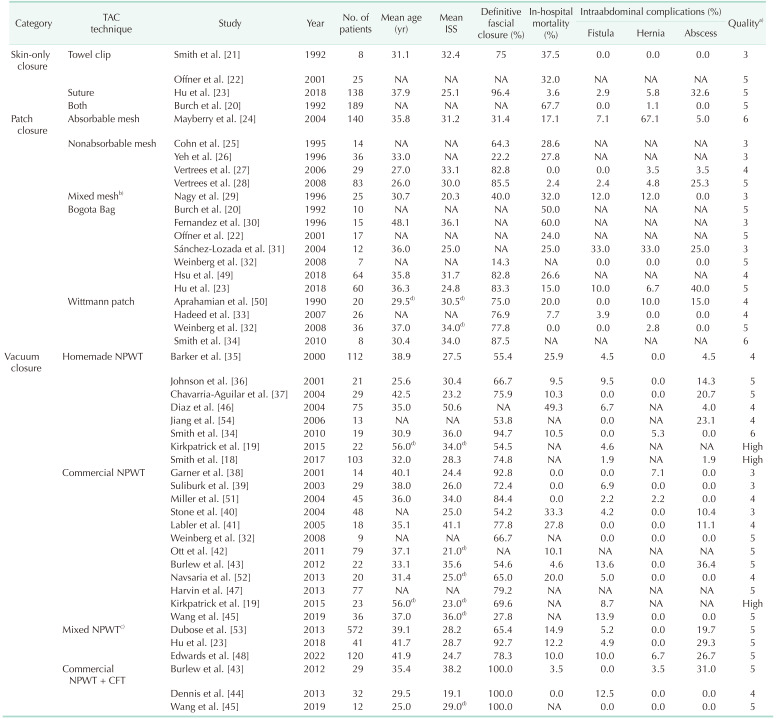




 PDF
PDF Citation
Citation Print
Print



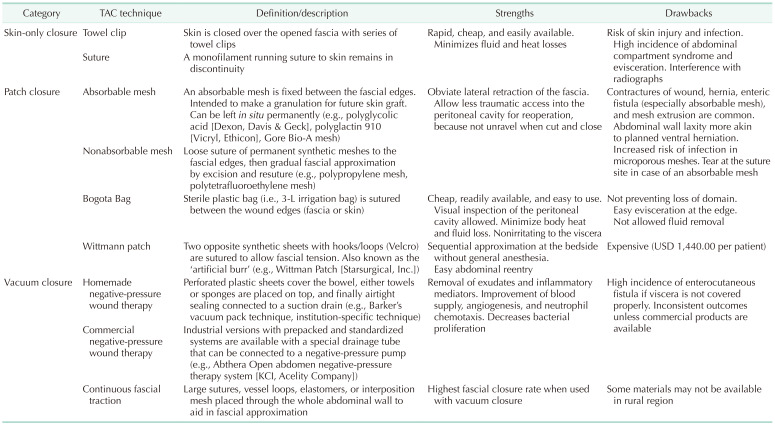

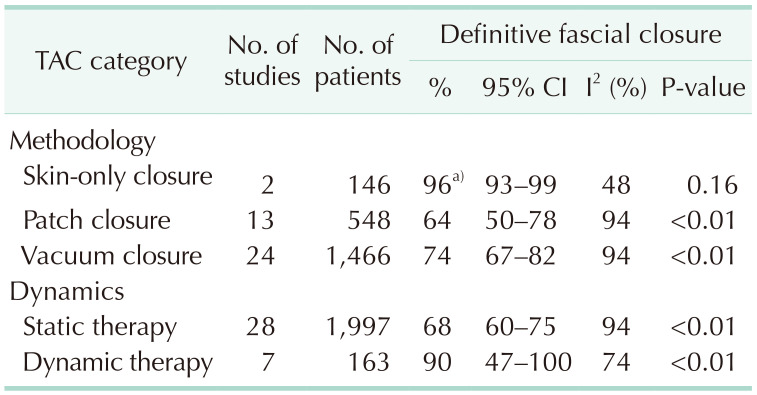
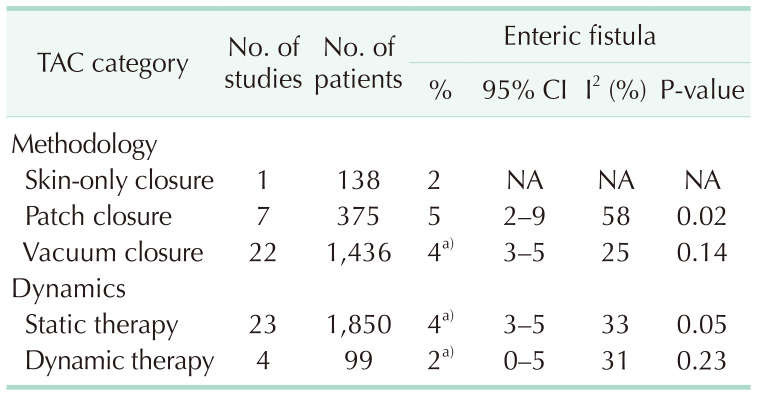
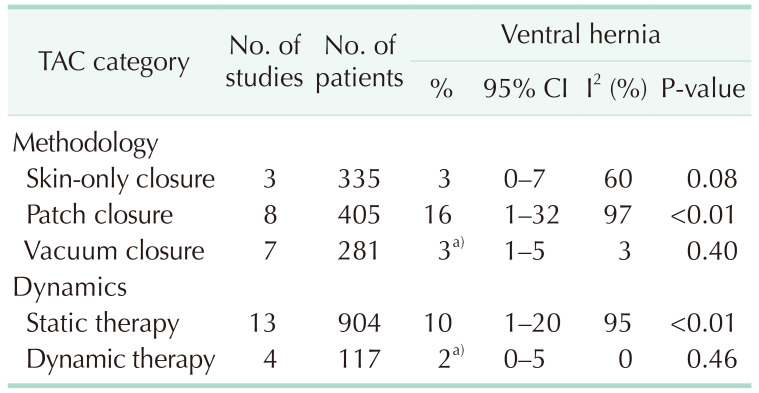
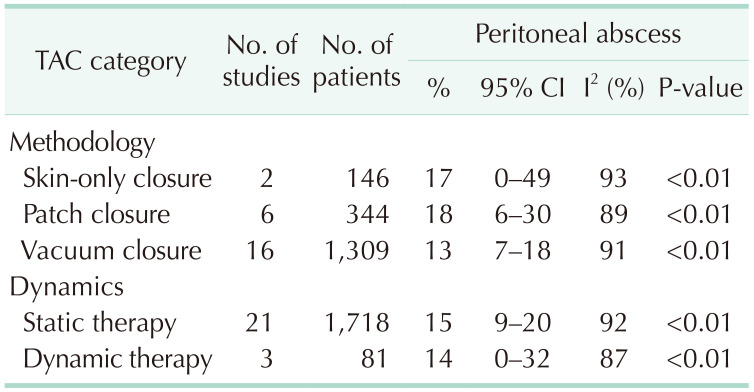
 XML Download
XML Download